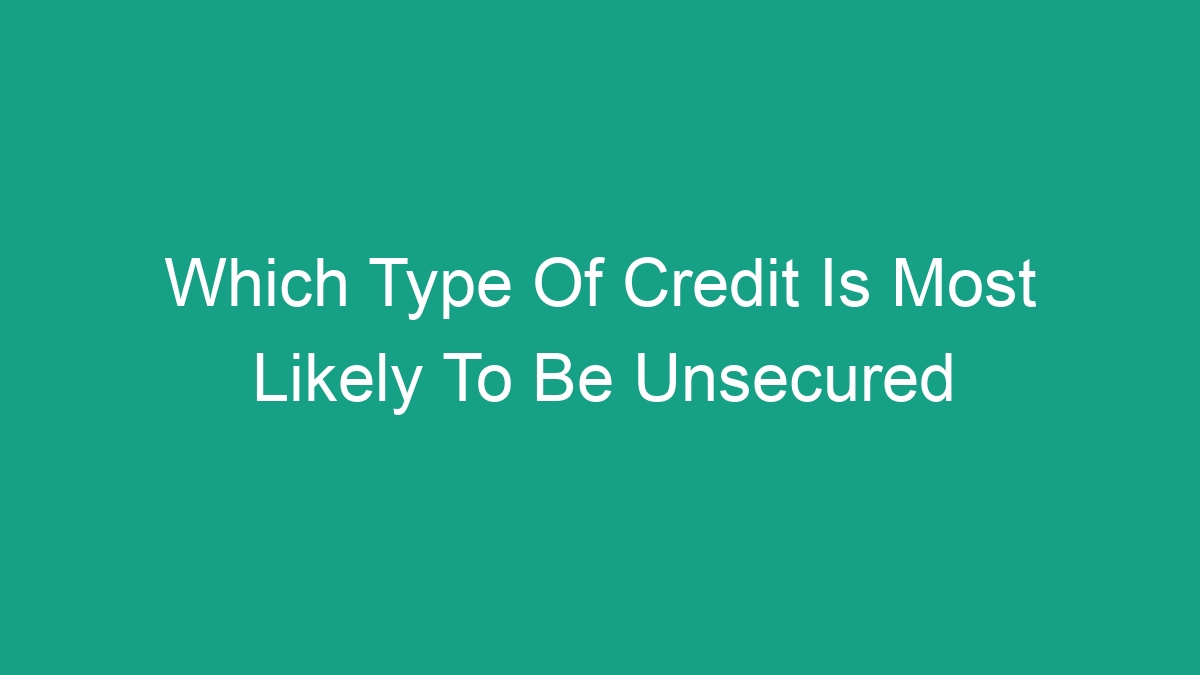
When it comes to borrowing money, there are two main types of credit: secured and unsecured. Secured credit requires collateral, while unsecured credit does not. In this article, we’ll explore which type of credit is most likely to be unsecured, as well as the various forms of unsecured credit available to consumers.
Understanding Secured vs Unsecured Credit
Secured credit is backed by an asset, such as a car or a house, which the lender can take possession of if the borrower defaults on the loan. This lowers the lender’s risk, making it easier for borrowers to obtain larger loans and better interest rates. On the other hand, unsecured credit does not require collateral, but relies solely on the borrower’s creditworthiness.
Types of Unsecured Credit
There are several types of unsecured credit, each with its own benefits and drawbacks. The most common forms of unsecured credit include:
- Credit Cards
- Personal Loans
- Student Loans
- Unsecured Lines of Credit
- Signature Loans
Credit Cards
Credit cards are one of the most popular forms of unsecured credit. They allow consumers to make purchases on credit, up to a predetermined credit limit. Unlike secured credit cards, unsecured credit cards do not require a security deposit in order to open an account.
Pros of Credit Cards
- Convenient for everyday purchases
- Can help build credit history
- Often come with rewards and perks
Cons of Credit Cards
- High-interest rates can lead to debt accumulation
- Overspending may lead to financial problems
- Annual fees and penalties for late payments
Personal Loans
Personal loans are another common form of unsecured credit. They are typically used for large one-time expenses, such as home improvements or debt consolidation. Personal loans have fixed monthly payments and a set repayment schedule.
Pros of Personal Loans
- Fixed interest rates make budgeting easier
- No collateral required
- Can be used for a variety of purposes
Cons of Personal Loans
- May require a good credit score for favorable terms
- Origination fees and prepayment penalties
- Defaulting can result in legal action
Student Loans
Student loans are designed to help students pay for higher education expenses, such as tuition, books, and living costs. These loans are typically unsecured, and the federal government offers several programs to help students manage their loan payments.
Pros of Student Loans
- Deferred payments while in school
- Low-interest rates compared to other unsecured loans
- Options for income-driven repayment plans
Cons of Student Loans
- Interest accrues while in deferment
- Can’t be discharged in bankruptcy
- Borrowing limits for federal loans
Unsecured Lines of Credit
An unsecured line of credit (LOC) is a revolving credit account that allows borrowers to access funds up to a predetermined limit. The borrower can use the funds as needed and only pay interest on the amount borrowed. Once repaid, the funds become available for use again.
Pros of Unsecured Lines of Credit
- Flexible borrowing and repayment options
- No collateral required
- Interest-only payments during the draw period
Cons of Unsecured Lines of Credit
- Variable interest rates may increase over time
- Temptation for continuous borrowing
- High credit limits can lead to increased debt
Signature Loans
Signature loans, also known as character loans, are unsecured personal loans that are approved based on the borrower’s creditworthiness and signature. These loans are often used for smaller loan amounts and have fixed terms and monthly payments.
Pros of Signature Loans
- No collateral required
- Can be used for various purposes
- Fast approval process
Cons of Signature Loans
- Higher interest rates compared to secured loans
- May require a good credit history
- Potential for high fees and penalties
The Most Likely Unsecured Credit
Based on the information above, it is clear that credit cards are the most likely type of credit to be unsecured. With no collateral required, credit cards offer consumers the flexibility to make purchases and pay them off over time. However, it’s important to use credit cards responsibly to avoid accumulating high-interest debt.
Conclusion
Unsecured credit offers consumers the ability to borrow money without the need for collateral. While this type of credit can be convenient and accessible, it’s crucial to understand the terms and conditions of each form of unsecured credit to make informed financial decisions.
FAQs
Which type of credit is most likely to be unsecured?
Credit cards are the most likely type of credit to be unsecured, as they do not require collateral and offer consumers the flexibility to make purchases on credit.
What are the pros and cons of unsecured credit?
Pros: No collateral required, convenient for everyday expenses, and can help build credit history.
Cons: High-interest rates, potential for debt accumulation, and fees for late payments.
Are there alternatives to unsecured credit?
Yes, secured credit options include secured credit cards, home equity loans, and secured personal loans, which require collateral to secure the loan.



